Unveiling the Spatial Variation in Ecosystem Services Interactions and Their Drivers Within the National Key Ecological Function Zones, China
Abstract
1. Introduction
2. Materials and Methods
2.1. Study Area
2.2. Data Sources
2.3. Methods
2.3.1. Ecosystem Services Assessment
- (1)
- Net primary productivity (NPP)
- (2)
- Water retention
- (3)
- Soil conservation
- (4)
- Biodiversity maintenance
- (5)
- Sandstorm prevention
- (6)
- Technical validation
2.3.2. Statistical Analysis Methods
- (1)
- Time series trend analysis
- (2)
- ES interactions assessment
- (3)
- Optimal parameter-based geographical detector model
- (4)
- Constraint line method
3. Results
3.1. Spatial and Temporal Patterns of Ecosystem Services
3.2. Interactions Between Ecosystem Services
3.3. Driving Factors and Their Constraints
4. Discussion
4.1. Spatiotemporal Dynamics of Ecosystem Services
4.2. Ecosystem Services Interactions and Potential Driving Mechanisms
4.3. Implications
5. Conclusions
Supplementary Materials
Author Contributions
Funding
Data Availability Statement
Conflicts of Interest
References
- Millennium Ecosystem Assessment (MEA). Ecosystems and Human WellBeing: Synthesis; Island Press: Washington, DC, USA, 2005. [Google Scholar]
- Costanza, R.; de Groot, R.; Braat, L.; Kubiszewski, I.; Fioramonti, L.; Sutton, P.; Farber, S.; Grasso, M. Twenty Years of Ecosystem Services: How Far Have We Come and How Far Do We Still Need to Go? Ecosyst. Serv. 2017, 28, 1–16. [Google Scholar] [CrossRef]
- Díaz, S.; Pascual, U.; Stenseke, M.; Martín-López, B.; Watson, R.T.; Molnár, Z.; Hill, R.; Chan, K.M.A.; Baste, I.A.; Brauman, K.A.; et al. Assessing Nature’s Contributions to People. Science 2018, 359, 270–272. [Google Scholar] [CrossRef] [PubMed]
- Brauman, K.A.; Garibaldi, L.A.; Polasky, S.; Aumeeruddy-Thomas, Y.; Brancalion, P.H.S.; DeClerck, F.; Jacob, U.; Mastrangelo, M.E.; Nkongolo, N.V.; Palang, H.; et al. Global Trends in Nature’s Contributions to People. Proc. Natl. Acad. Sci. USA 2020, 117, 32799–32805. [Google Scholar] [CrossRef] [PubMed]
- Carpenter, S.R.; Mooney, H.A.; Agard, J.; Capistrano, D.; DeFries, R.S.; Diaz, S.; Dietz, T.; Duraiappah, A.K.; Oteng-Yeboah, A.; Pereira, H.M.; et al. Science for Managing Ecosystem Services: Beyond the Millennium Ecosystem Assessment. Proc. Natl. Acad. Sci. USA 2009, 106, 1305–1312. [Google Scholar] [CrossRef]
- Costanza, R.; de Groot, R.; Sutton, P.; van der Ploeg, S.; Anderson, S.J.; Kubiszewski, I.; Farber, S.; Turner, R.K. Changes in the Global Value of Ecosystem Services. Glob. Environ. Change 2014, 26, 152–158. [Google Scholar] [CrossRef]
- Bennett, E.M.; Peterson, G.D.; Gordon, L.J. Understanding Relationships among Multiple Ecosystem Services: Relationships among Multiple Ecosystem Services. Ecol. Lett. 2009, 12, 1394–1404. [Google Scholar] [CrossRef]
- Lee, H.; Lautenbach, S. A Quantitative Review of Relationships between Ecosystem Services. Ecol. Indic. 2016, 66, 340–351. [Google Scholar] [CrossRef]
- Zhang, H.; Liu, S. Exploring the Spatial–Temporal Patterns of Urban Ecosystem Service Relationships and Their Driving Mechanisms: A Case Study of Wuhu City, China. Ecol. Indic. 2024, 167, 112726. [Google Scholar] [CrossRef]
- Dade, M.C.; Mitchell, M.G.E.; McAlpine, C.A.; Rhodes, J.R. Assessing Ecosystem Service Trade-Offs and Synergies: The Need for a More Mechanistic Approach. Ambio 2019, 48, 1116–1128. [Google Scholar] [CrossRef]
- Zhang, Y.; Wu, T.; Song, C.; Hein, L.; Shi, F.; Han, M.; Ouyang, Z. Influences of Climate Change and Land Use Change on the Interactions of Ecosystem Services in China’s Xijiang River Basin. Ecosyst. Serv. 2022, 58, 101489. [Google Scholar] [CrossRef]
- Ndong, G.O.; Therond, O.; Cousin, I. Analysis of Relationships between Ecosystem Services: A Generic Classification and Review of the Literature. Ecosyst. Serv. 2020, 43, 101120. [Google Scholar] [CrossRef]
- Anderson, B.J.; Armsworth, P.R.; Eigenbrod, F.; Thomas, C.D.; Gillings, S.; Heinemeyer, A.; Roy, D.B.; Gaston, K.J. Spatial Covariance between Biodiversity and Other Ecosystem Service Priorities. J. Appl. Ecol. 2009, 46, 888–896. [Google Scholar] [CrossRef]
- Qiu, J.; Turner, M.G. Spatial Interactions among Ecosystem Services in an Urbanizing Agricultural Watershed. Proc. Natl. Acad. Sci. USA 2013, 110, 12149–12154. [Google Scholar] [CrossRef]
- Luo, K.; Wang, H.; Yan, X.; Ma, C.; Zheng, X.; Wu, J.; Wu, C. Study on Trade-Offs and Synergies of Rural Ecosystem Services in the Tacheng-Emin Basin, Xinjiang, China: Implications for Zoning Management of Rural Ecological Functions. J. Environ. Manag. 2024, 363, 121411. [Google Scholar] [CrossRef] [PubMed]
- Yang, M.; Gao, X.; Siddique, K.H.M.; Wu, P.; Zhao, X. Spatiotemporal Exploration of Ecosystem Service, Urbanization, and Their Interactive Coercing Relationship in the Yellow River Basin over the Past 40 Years. Sci. Total Environ. 2023, 858, 159757. [Google Scholar] [CrossRef]
- Xue, C.; Xue, L.; Chen, J.; Tarolli, P.; Chen, X.; Zhang, H.; Qian, J.; Zhou, Y.; Liu, X. Understanding Driving Mechanisms behind the Supply-Demand Pattern of Ecosystem Services for Land-Use Administration: Insights from a Spatially Explicit Analysis. J. Clean. Prod. 2023, 427, 139239. [Google Scholar] [CrossRef]
- Wang, M.; Wang, X.; Shi, W. Exploring the Response of Trade-Offs and Synergies among Ecosystem Services to Future Land Use Changes in the Hilly Red Soil Region of Southern China. J. Environ. Manag. 2024, 372, 123283. [Google Scholar] [CrossRef]
- Xue, C.; Chen, X.; Xue, L.; Zhang, H.; Chen, J.; Li, D. Modeling the Spatially Heterogeneous Relationships between Tradeoffs and Synergies among Ecosystem Services and Potential Drivers Considering Geographic Scale in Bairin Left Banner, China. Sci. Total Environ. 2023, 855, 158834. [Google Scholar] [CrossRef]
- Raudsepp-Hearne, C.; Peterson, G.D.; Bennett, E.M. Ecosystem Service Bundles for Analyzing Tradeoffs in Diverse Landscapes. Proc. Natl. Acad. Sci. USA 2010, 107, 5242–5247. [Google Scholar] [CrossRef]
- Liu, Y.; Zhang, C.; Zeng, H. Constraint Effects among Several Key Ecosystem Service Types and Their Influencing Factors: A Case Study of the Pearl River Delta, China. Ecol. Indic. 2023, 146, 109883. [Google Scholar] [CrossRef]
- Yu, H.; Jiang, J.; Gu, X.; Cao, C.; Shen, C. Using Dynamic Bayesian Belief Networks to Infer the Effects of Climate Change and Human Activities on Changes in Regional Ecosystem Services. Ecol. Indic. 2025, 170, 113023. [Google Scholar] [CrossRef]
- Li, J.; Xie, B.; Gao, C.; Zhou, K.; Liu, C.; Zhao, W.; Xiao, J.; Xie, J. Impacts of Natural and Human Factors on Water-Related Ecosystem Services in the Dongting Lake Basin. J. Clean. Prod. 2022, 370, 133400. [Google Scholar] [CrossRef]
- Liu, J.; Pei, X.; Liao, B.; Zhang, H.; Liu, W.; Jiao, J. Scale Effects and Spatial Heterogeneity of Driving Factors in Ecosystem Services Value Interactions within the Tibet Autonomous Region. J. Environ. Manag. 2024, 351, 119871. [Google Scholar] [CrossRef]
- Song, Y.; Wang, J.; Ge, Y.; Xu, C. An Optimal Parameters-Based Geographical Detector Model Enhances Geographic Characteristics of Explanatory Variables for Spatial Heterogeneity Analysis: Cases with Different Types of Spatial Data. GISci. Remote Sens. 2020, 57, 593–610. [Google Scholar] [CrossRef]
- Lester, S.E.; Costello, C.; Halpern, B.S.; Gaines, S.D.; White, C.; Barth, J.A. Evaluating Tradeoffs among Ecosystem Services to Inform Marine Spatial Planning. Mar. Policy 2013, 38, 80–89. [Google Scholar] [CrossRef]
- Yang, M.; Chen, Y.; Yang, Y.; Yan, Y. Nonlinear Relationship and Threshold-Based Zones between Ecosystem Service Supply-Demand Ratio and Land Use Intensity: A Case Study of the Beijing-Tianjin-Hebei Region, China. J. Clean. Prod. 2024, 481, 144148. [Google Scholar] [CrossRef]
- Zhang, X.; Shao, Q.; Wang, B.; Niu, X.; Ning, J.; Chen, M.; Zhang, T.; Liu, G.; Liu, S.; Niu, L.; et al. Spatiotemporal Analysis of Ecosystem Status in China’s National Key Ecological Function Zones. Remote Sens. 2023, 15, 4641. [Google Scholar] [CrossRef]
- Zhang, M.; Zhang, L.; He, H.; Ren, X.; Lv, Y.; Niu, Z.; Chang, Q.; Xu, Q.; Liu, W. Improvement of Ecosystem Quality in National Key Ecological Function Zones in China during 2000–2015. J. Environ. Manag. 2022, 324, 116406. [Google Scholar] [CrossRef] [PubMed]
- Tilman, D.; Knops, J.; Wedin, D.; Reich, P.; Ritchie, M.; Siemann, E. The Influence of Functional Diversity and Composition on Ecosystem Processes. Science 1997, 277, 1300–1302. [Google Scholar] [CrossRef]
- Zheng, Y.; Shen, R.; Wang, Y.; Li, X.; Liu, S.; Liang, S.; Chen, J.; Ju, W.; Zhang, L.; Yuan, W. Improved Estimate of Global Gross Primary Production for Reproducing Its Long-Term Variation, 1982–2017. Earth Syst. Sci. Data 2020, 12, 2725–2746. [Google Scholar] [CrossRef]
- Terrado, M.; Sabater, S.; Chaplin-Kramer, B.; Mandle, L.; Ziv, G.; Acuña, V. Model Development for the Assessment of Terrestrial and Aquatic Habitat Quality in Conservation Planning. Sci. Total Environ. 2016, 540, 63–70. [Google Scholar] [CrossRef] [PubMed]
- Zhang, L.; Xiao, Y.; Zheng, H.; Xu, W.; Lu, F.; Jiang, L.; Rao, E.; Xiao, Y.; Wu, B.; Zeng, Y.; et al. A spatial dataset of ecosystem services in China (2010). Sci. Data Bank 2017, 3, 11–23. [Google Scholar] [CrossRef]
- Li, J.; He, H.; Zeng, Q.; Chen, L.; Sun, R. A Chinese Soil Conservation Dataset Preventing Soil Water Erosion from 1992 to 2019. Sci. Data 2023, 10, 319. [Google Scholar] [CrossRef] [PubMed]
- Gong, S.; Xiao, Y.; Zheng, H.; Xiao, Y.; Ouyang, Z. Spatial patterns of ecosystem water conservation in China and its impact factors analysis. Acta Ecol. Sin. 2017, 37, 2455–2462. (In Chinese) [Google Scholar] [CrossRef]
- Huang, B.; Lu, F.; Wang, X.; Wu, X.; Zheng, H.; Su, Y.; Yuan, Y.; Ouyang, Z. The Impact of Ecological Restoration on Ecosystem Services Change Modulated by Drought and Rising CO2. Glob. Change Biol. 2023, 29, 5304–5320. [Google Scholar] [CrossRef]
- Yin, L.; Wang, X.; Wang, Y. 1-km Resolution Dataset of Water Yield in the National Ecological Barrier Zone (2000–2015). J. Glob. Change Data Discov. 2020, 4, 332–337. (In Chinese) [Google Scholar] [CrossRef]
- Zhang, H.; Fan, J.; Cao, W.; Harris, W.; Li, Y.; Chi, W.; Wang, S. Response of Wind Erosion Dynamics to Climate Change and Human Activity in Inner Mongolia, China during 1990 to 2015. Sci. Total Environ. 2018, 639, 1038–1050. [Google Scholar] [CrossRef]
- Zhang, C.; Fan, N.; Liu, C.; Xie, G. Spatio-temporal pattern and evolution of ecosystem water conservation in China from 1990 to 2018. Acta Ecol. Sin. 2023, 43, 5536–5545. (In Chinese) [Google Scholar] [CrossRef]
- Zhao, Y.; Chi, W.; Kuang, W.; Bao, Y.; Ding, G. Ecological and Environmental Consequences of Ecological Projects in the Beijing–Tianjin Sand Source Region. Ecol. Indic. 2020, 112, 106111. [Google Scholar] [CrossRef]
- Meng, X.; Gao, X.; Li, S.; Lei, J. Spatial and temporal characteristics of vegetation NDVI changes and the driving forces in Mongolia during 1982–2015. Remote Sens. 2020, 12, 603. [Google Scholar] [CrossRef]
- Spake, R.; Lasseur, R.; Crouzat, E.; Bullock, J.M.; Lavorel, S.; Parks, K.E.; Schaafsma, M.; Bennett, E.M.; Maes, J.; Mulligan, M.; et al. Unpacking Ecosystem Service Bundles: Towards Predictive Mapping of Synergies and Trade-Offs between Ecosystem Services. Glob. Environ. Change-Hum. Policy Dimens. 2017, 47, 37–50. [Google Scholar] [CrossRef]
- Qiao, J.; Deng, L.; Liu, H.; Wang, Z. Spatiotemporal Heterogeneity in Ecosystem Service Trade-Offs and Their Drivers in the Huang-Huai-Hai Plain, China. Landsc. Ecol. 2024, 39, 42. [Google Scholar] [CrossRef]
- Liu, L.; Wu, J. Ecosystem Services-Human Wellbeing Relationships Vary with Spatial Scales and Indicators: The Case of China. Resour. Conserv. Recycl. 2021, 172, 105662. [Google Scholar] [CrossRef]
- Qiao, J.; Yu, D.; Cao, Q.; Hao, R. Identifying the Relationships and Drivers of Agro-Ecosystem Services Using a Constraint Line Approach in the Agro-Pastoral Transitional Zone of China. Ecol. Indic. 2019, 106, 105439. [Google Scholar] [CrossRef]
- Ouyang, Z.; Zheng, H.; Xiao, Y.; Polasky, S.; Liu, J.; Xu, W.; Wang, Q.; Zhang, L.; Xiao, Y.; Rao, E.; et al. Improvements in Ecosystem Services from Investments in Natural Capital. Science 2016, 352, 1455–1459. [Google Scholar] [CrossRef]
- Chen, X.; Yu, L.; Du, Z.; Xu, Y.; Zhao, J.; Zhao, H.; Zhang, G.; Peng, D.; Gong, P. Distribution of Ecological Restoration Projects Associated with Land Use and Land Cover Change in China and Their Ecological Impacts. Sci. Total Environ. 2022, 825, 153938. [Google Scholar] [CrossRef]
- Chen, C.; Park, T.; Wang, X.; Piao, S.; Xu, B.; Chaturvedi, R.K.; Fuchs, R.; Brovkin, V.; Ciais, P.; Fensholt, R.; et al. China and India Lead in Greening of the World through Land-Use Management. Nat. Sustain. 2019, 2, 122–129. [Google Scholar] [CrossRef]
- Cheng, K.; Yang, H.; Tao, S.; Su, Y.; Guan, H.; Ren, Y.; Hu, T.; Li, W.; Xu, G.; Chen, M.; et al. Carbon Storage through China’s Planted Forest Expansion. Nat. Commun. 2024, 15, 4106. [Google Scholar] [CrossRef] [PubMed]
- Xu, Y.; Lu, Y.; Zou, B.; Xu, M.; Feng, Y. Unraveling the Enigma of NPP Variation in Chinese Vegetation Ecosystems: The Interplay of Climate Change and Land Use Change. Sci. Total Environ. 2024, 912, 169023. [Google Scholar] [CrossRef]
- Zhang, Y.; Li, C.; Chiew, F.H.S.; Post, D.A.; Zhang, X.; Ma, N.; Tian, J.; Kong, D.; Leung, L.R.; Yu, Q.; et al. Southern Hemisphere Dominates Recent Decline in Global Water Availability. Science 2023, 382, 579–584. [Google Scholar] [CrossRef]
- Wang, Z.; Tang, Q.; Wang, D.; Xiao, P.; Xia, R.; Sun, P.; Feng, F. Attributing Trend in Naturalized Streamflow to Temporally Explicit Vegetation Change and Climate Variation in the Yellow River Basin of China. Hydrol. Earth Syst. Sci. 2022, 26, 5291–5314. [Google Scholar] [CrossRef]
- Chen, G.; Zuo, D.; Xu, Z.; Wang, G.; Han, Y.; Peng, D.; Pang, B.; Abbaspour, K.C.; Yang, H. Changes in Water Conservation and Possible Causes in the Yellow River Basin of China during the Recent Four Decades. J. Hydrol. 2024, 637, 131314. [Google Scholar] [CrossRef]
- Zheng, J.; Li, B.; Chen, Y.; Chen, Z.; Lian, L. Spatiotemporal Variation of Upper-Air and Surface Wind Speed and Its Influencing Factors in Northwestern China during 1980–2012. Theor. Appl. Climatol. 2018, 133, 1303–1314. [Google Scholar] [CrossRef]
- Ding, Y.; Li, X.; Li, Q. Advances of surface wind speed changes over China under global warming. J. Appl. Meteorol. Sci. 2020, 31, 1–12. (In Chinese) [Google Scholar] [CrossRef]
- Grêt-Regamey, A.; Sirén, E.; Brunner, S.H.; Weibel, B. Review of Decision Support Tools to Operationalize the Ecosystem Services Concept. Ecosyst. Serv. 2017, 26, 306–315. [Google Scholar] [CrossRef]
- Hamel, P.; Bryant, B.P. Uncertainty Assessment in Ecosystem Services Analyses: Seven Challenges and Practical Responses. Ecosyst. Serv. 2017, 24, 1–15. [Google Scholar] [CrossRef]
- Xu, H.; Zhao, C.; Chen, S.; Shan, S.; Qi, X.; Chen, T.; Wang, X. Spatial Relationships among Regulating Ecosystem Services in Mountainous Regions: Nonlinear and Elevation-Dependent. J. Clean. Prod. 2022, 380, 135050. [Google Scholar] [CrossRef]
- Zhang, T.; Zhang, S.; Cao, Q.; Wang, H.; Li, Y. The Spatiotemporal Dynamics of Ecosystem Services Bundles and the Social-Economic-Ecological Drivers in the Yellow River Delta Region. Ecol. Indic. 2022, 135, 108573. [Google Scholar] [CrossRef]
- Xiao, L.; Li, G.; Zhao, R.; Zhang, L. Effects of Soil Conservation Measures on Wind Erosion Control in China: A Synthesis. Sci. Total Environ. 2021, 778, 146308. [Google Scholar] [CrossRef]
- Xue, C.; Zhang, H.; Wu, S.; Chen, J.; Chen, X. Spatial-Temporal Evolution of Ecosystem Services and Its Potential Drivers: A Geospatial Perspective from Bairin Left Banner, China. Ecol. Indic. 2022, 137, 108760. [Google Scholar] [CrossRef]
- Lü, Y.; Wang, Y.; Yin, L.; Lü, D.; Wang, X. Climate and Scale Are Critical for Illustrating the Links between Carbon and Water Services across Qinghai-Tibet Plateau. Catena 2023, 231, 107379. [Google Scholar] [CrossRef]
- Hao, R.F.; Yu, D.Y.; Wu, J.G.; Guo, Q.F.; Liu, Y.P. Constraint line methods and the applications in ecology. Chin. J. Plant Ecol. 2016, 40, 1100–1109. (In Chinese) [Google Scholar] [CrossRef]
- Chen, Y.; Wang, K.; Fu, B.; Wang, Y.; Tian, H.; Wang, Y.; Zhang, Y. 65% Cover Is the Sustainable Vegetation Threshold on the Loess Plateau. Environ. Sci. Ecotechnol. 2024, 22, 100442. [Google Scholar] [CrossRef]
- Yu, F.; Li, C.; Yuan, Z.; Luo, Y.; Yin, Q.; Wang, Q.; Hao, Z. How Do Mountain Ecosystem Services Respond to Changes in Vegetation and Climate? An Evidence from the Qinling Mountains, China. Ecol. Indic. 2023, 154, 110922. [Google Scholar] [CrossRef]
- Wang, Y.; Wang, H.; Zhang, J.; Liu, G.; Fang, Z.; Wang, D. Exploring Interactions in Water-Related Ecosystem Services Nexus in Loess Plateau. J. Environ. Manag. 2023, 336, 117550. [Google Scholar] [CrossRef]
- He, L.; Xie, Z.; Wu, H.; Liu, Z.; Zheng, B.; Wan, W. Exploring the Interrelations and Driving Factors among Typical Ecosystem Services in the Yangtze River Economic Belt, China. J. Environ. Manag. 2024, 351, 119794. [Google Scholar] [CrossRef]
- Ding, X.; Jian, S. Synergies and Trade-Offs of Ecosystem Services Affected by Land Use Structures of Small Watershed in the Loess Plateau. J. Environ. Manag. 2024, 350, 119589. [Google Scholar] [CrossRef]
- Li, X.; Li, X.; Li, X.; Dong, Z.; Chen, X.; Guo, J.; Liu, H. Spatiotemporal Heterogeneity of Ecosystem Service Interactions and Their Determining Thresholds across Distinct Climate Zones in the Temperate Desert Steppe of Northern China. Ecol. Indic. 2025, 170, 113099. [Google Scholar] [CrossRef]
- Medinski, T.V.; Mills, A.J.; Esler, K.J.; Schmiedel, U.; Jürgens, N. Do Soil Properties Constrain Species Richness? Insights from Boundary Line Analysis across Several Biomes in South Western Africa. J. Arid Environ. 2010, 74, 1052–1060. [Google Scholar] [CrossRef]
- Ran, P.; Hu, S.; Frazier, A.E.; Yang, S.; Song, X.; Qu, S. The Dynamic Relationships between Landscape Structure and Ecosystem Services: An Empirical Analysis from the Wuhan Metropolitan Area, China. J. Environ. Manag. 2023, 325, 116575. [Google Scholar] [CrossRef]
- Wang, L.; Zheng, H.; Wen, Z.; Liu, L.; Robinson, B.E.; Li, R.; Li, C.; Kong, L. Ecosystem Service Synergies/Trade-Offs Informing the Supply-Demand Match of Ecosystem Services: Framework and Application. Ecosyst. Serv. 2019, 37, 100939. [Google Scholar] [CrossRef]
- Mitchell, M.G.E.; Suarez-Castro, A.F.; Martinez-Harms, M.; Maron, M.; McAlpine, C.; Gaston, K.J.; Johansen, K.; Rhodes, J.R. Reframing Landscape Fragmentation’s Effects on Ecosystem Services. Trends Ecol. Evol. 2015, 30, 190–198. [Google Scholar] [CrossRef] [PubMed]
- Duarte, G.T.; Santos, P.M.; Cornelissen, T.G.; Ribeiro, M.C.; Paglia, A.P. The Effects of Landscape Patterns on Ecosystem Services: Meta-Analyses of Landscape Services. Landsc. Ecol. 2018, 33, 1247–1257. [Google Scholar] [CrossRef]
- Huang, J.; Xia, Z.; Liu, L. Impacts of Landscape Configurations on Ecosystem Services and Their Trade-Offs across Different Landscape Compositions. Ecosyst. Serv. 2024, 70, 101666. [Google Scholar] [CrossRef]
- Assis, J.C.; Hohlenwerger, C.; Metzger, J.P.; Rhodes, J.R.; Duarte, G.T.; Da Silva, R.A.; Boesing, A.L.; Prist, P.R.; Ribeiro, M.C. Linking Landscape Structure and Ecosystem Service Flow. Ecosyst. Serv. 2023, 62, 101535. [Google Scholar] [CrossRef]
- Chen, S.; Liu, X.; Yang, L.; Zhu, Z. Variations in Ecosystem Service Value and Its Driving Factors in the Nanjing Metropolitan Area of China. Forests 2023, 14, 113. [Google Scholar] [CrossRef]
- Li, L.; Zhang, Y.; Wu, J.; Li, S.; Zhang, B.; Zu, J.; Zhang, H.; Ding, M.; Paudel, B. Increasing Sensitivity of Alpine Grasslands to Climate Variability along an Elevational Gradient on the Qinghai-Tibet Plateau. Sci. Total Environ. 2019, 678, 21–29. [Google Scholar] [CrossRef]
- Jia, Z.; Wang, X.; Feng, X.; Ma, J.; Wang, X.; Zhang, X.; Zhou, J.; Sun, Z.; Yao, W.; Tu, Y. Exploring the Spatial Heterogeneity of Ecosystem Services and Influencing Factors on the Qinghai Tibet Plateau. Ecol. Indic. 2023, 154, 110521. [Google Scholar] [CrossRef]
- Sun, S.; Lue, Y.; Fu, B. Relations between Physical and Ecosystem Service Flows of Freshwater Are Critical for Water Resource Security in Large Dryland River Basin. Sci. Total Environ. 2023, 857, 159549. [Google Scholar] [CrossRef]
- Bai, Y.; Wong, C.P.; Jiang, B.; Hughes, A.C.; Wang, M.; Wang, Q. Developing China’s Ecological Redline Policy Using Ecosystem Services Assessments for Land Use Planning. Nat. Commun. 2018, 9, 3034. [Google Scholar] [CrossRef]
- Fang, L.; Wang, L.; Chen, W.; Sun, J.; Cao, Q.; Wang, S.; Wang, L. Identifying the Impacts of Natural and Human Factors on Ecosystem Service in the Yangtze and Yellow River Basins. J. Clean. Prod. 2021, 314, 127995. [Google Scholar] [CrossRef]
- Gao, S.; Zhang, C.; Zou, X. Benefits of Beijing-Tianjin Sand Source Control Engineering; Science Press: Beijing, China, 2008. (In Chinese) [Google Scholar]
- Hu, Y.; Zhang, Y. Using ~(137)Cs and ~(210)Pb_(ex) to Investigate the Soil Erosion and Accumulation Moduli on the Southern Margin of the Hunshandake Sandy Land in Inner Mongolia. Acta Geogr. Sin. 2019, 74, 1890–1903. [Google Scholar] [CrossRef]
- Jia, W.; Li, Q.; Li, X.; Xie, B.; Wang, C. The Spatial and Temporal Variation of Soil Wind Erosion Modulus in the Baishan Region of Hebei Province from 2000 to 2018. J. Desert Res. 2024, 44, 130–141. (In Chinese) [Google Scholar]
- Li, Q.; Zhou, N.; Wang, S.; Li, T.; Wang, R.; Wang, J. Quantitative Assessment the Impacts of Climate Change and Human Actives on Wind Erosion: A Case Study of Inner Mongolia Autonomous Region. J. Desert Res. 2024, 44, 178–188. (In Chinese) [Google Scholar]
- Liu, J.; Qi, Y.; Shi, H.; Zhuang, D.; Hu, Y. 137Cs Tracing Analysis of Soil Wind Erosion Rate in the Taryat-Xilin Gol Transect of the Mongolian Plateau. Chin. Sci. Bull. 2007, 52, 2785–2791. (In Chinese) [Google Scholar]
- Williams, J. The Erosion-Productivity Impact Calculator (EPIC) Model—A Case History. Philos. Trans. R. Soc. B Biol. Sci. 1990, 329, 421–428. [Google Scholar] [CrossRef]
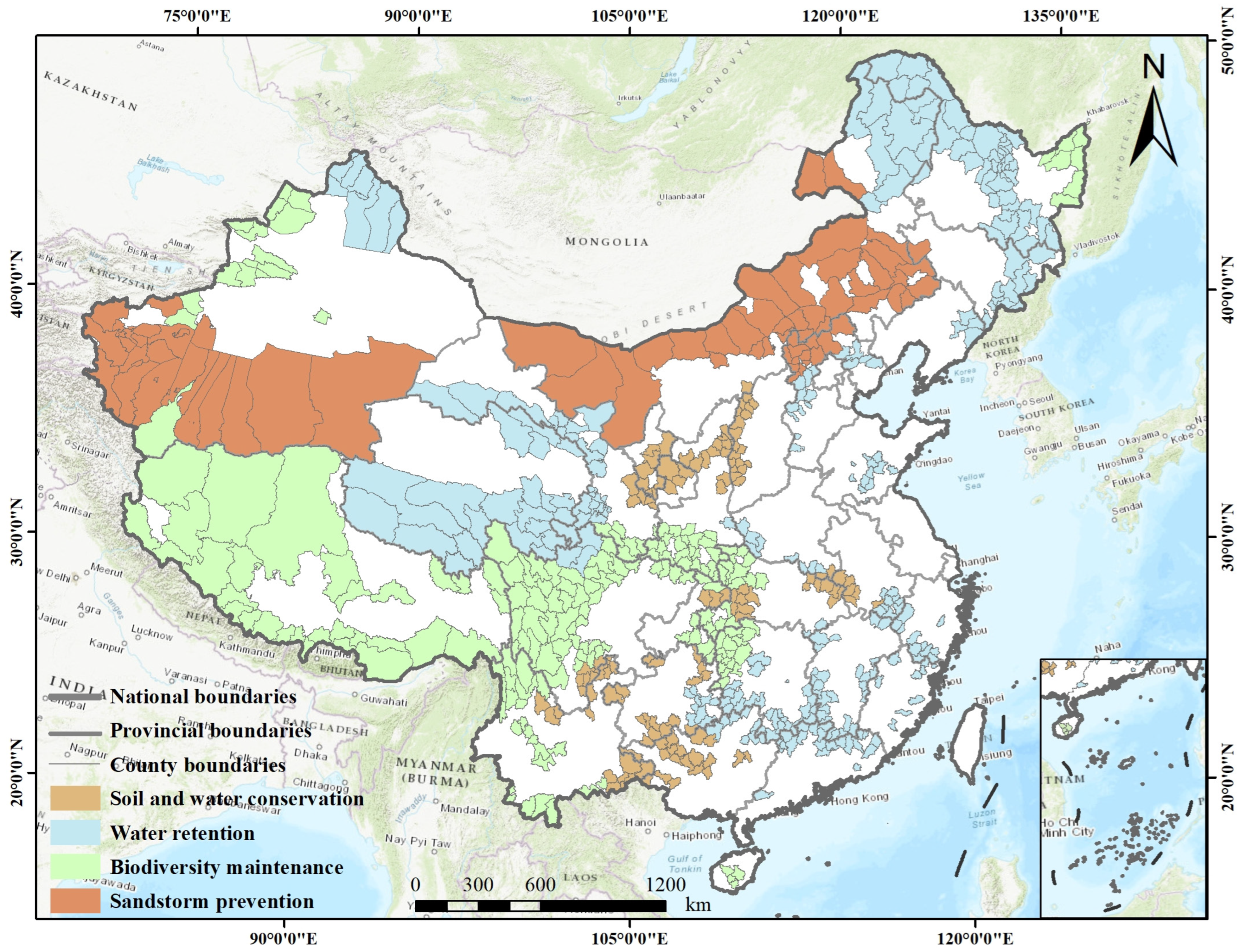

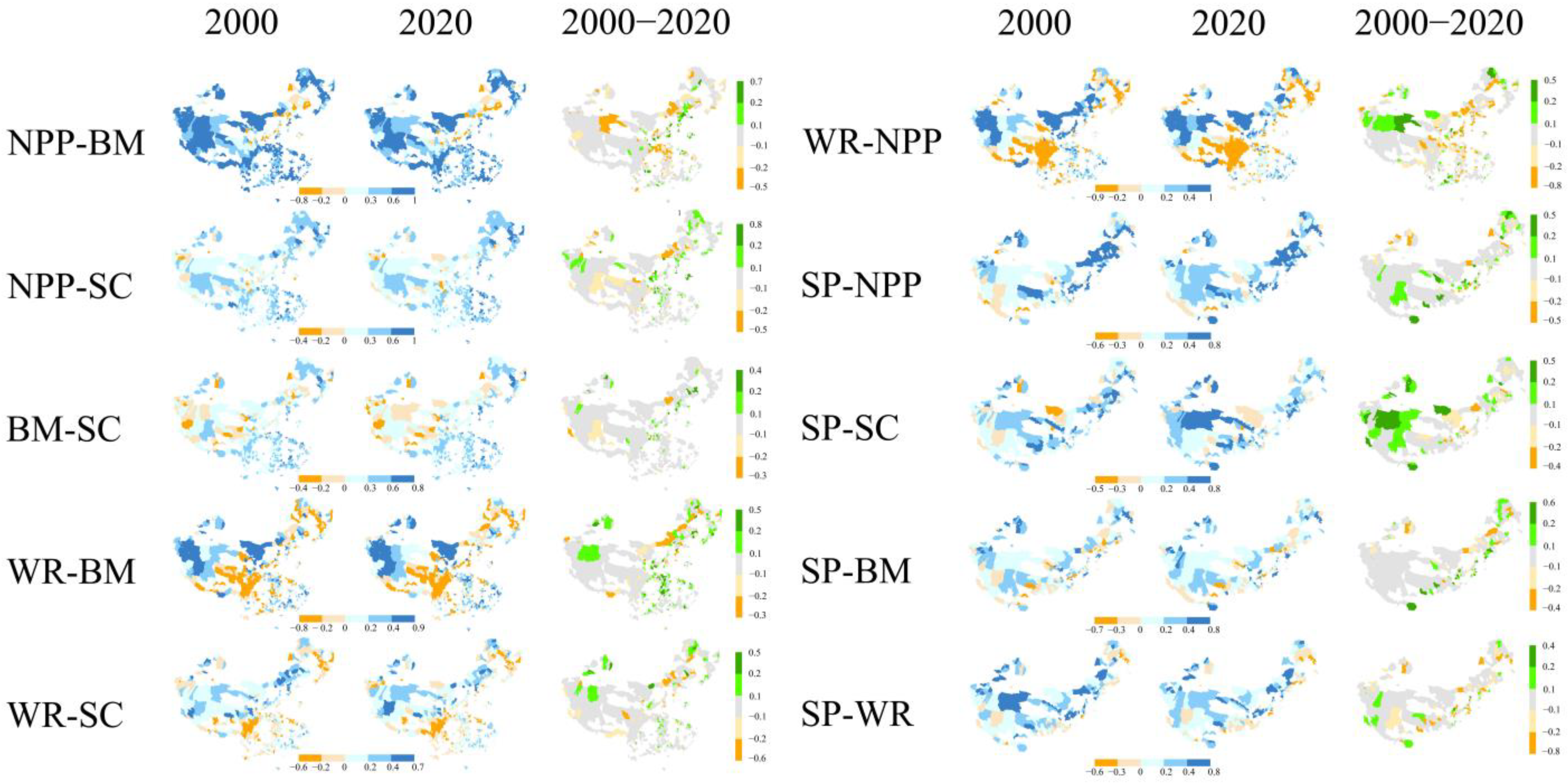
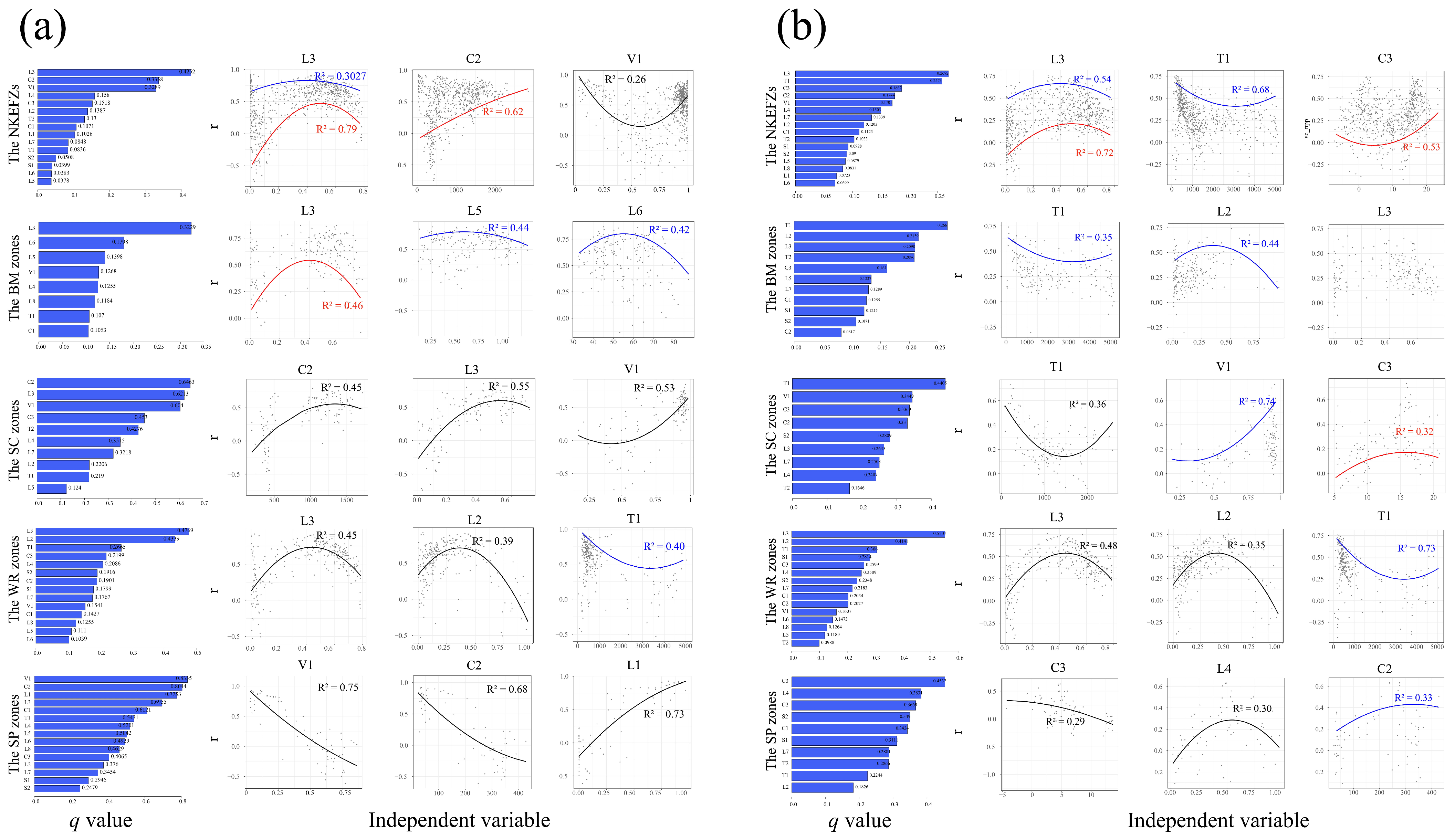
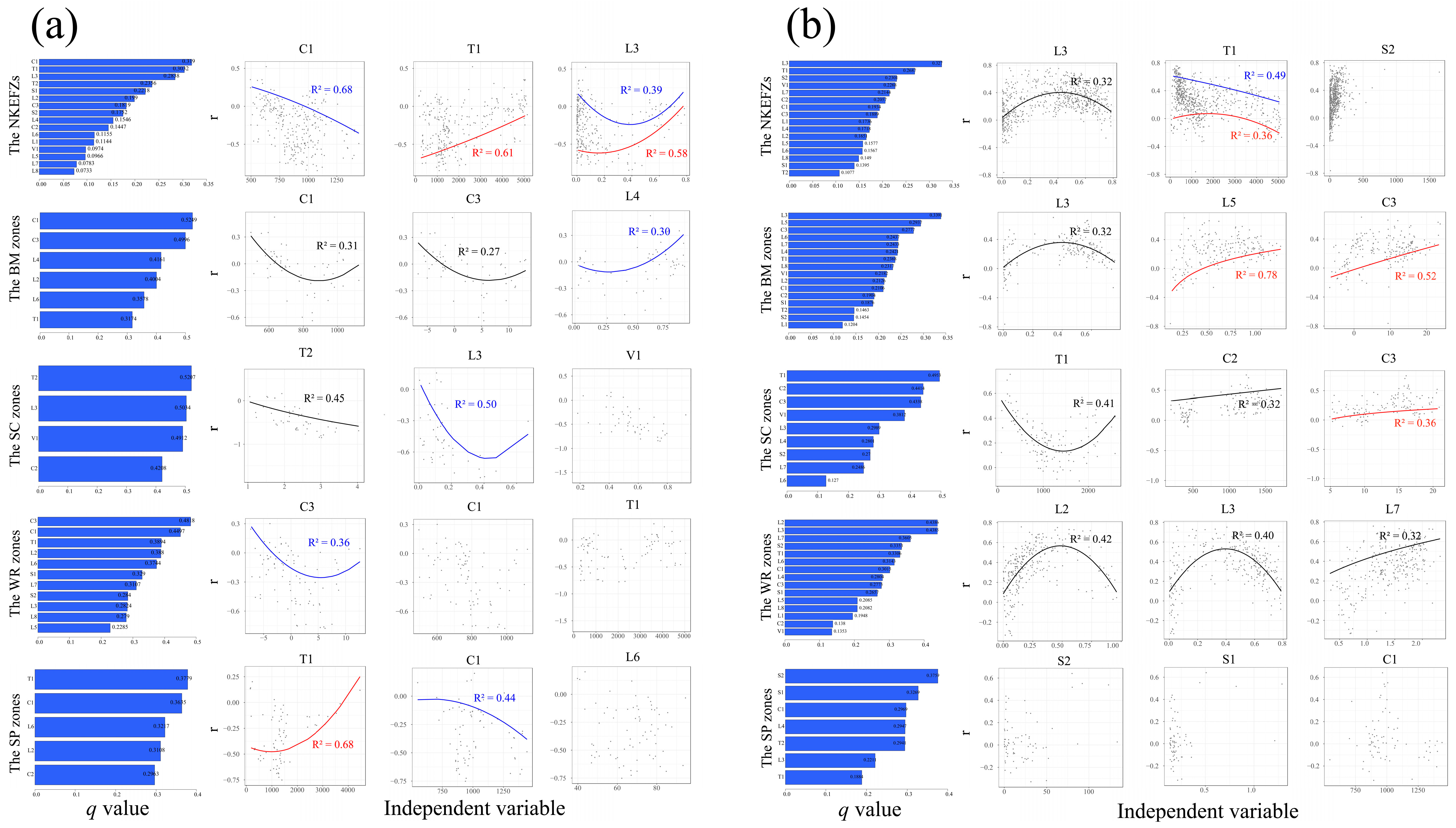


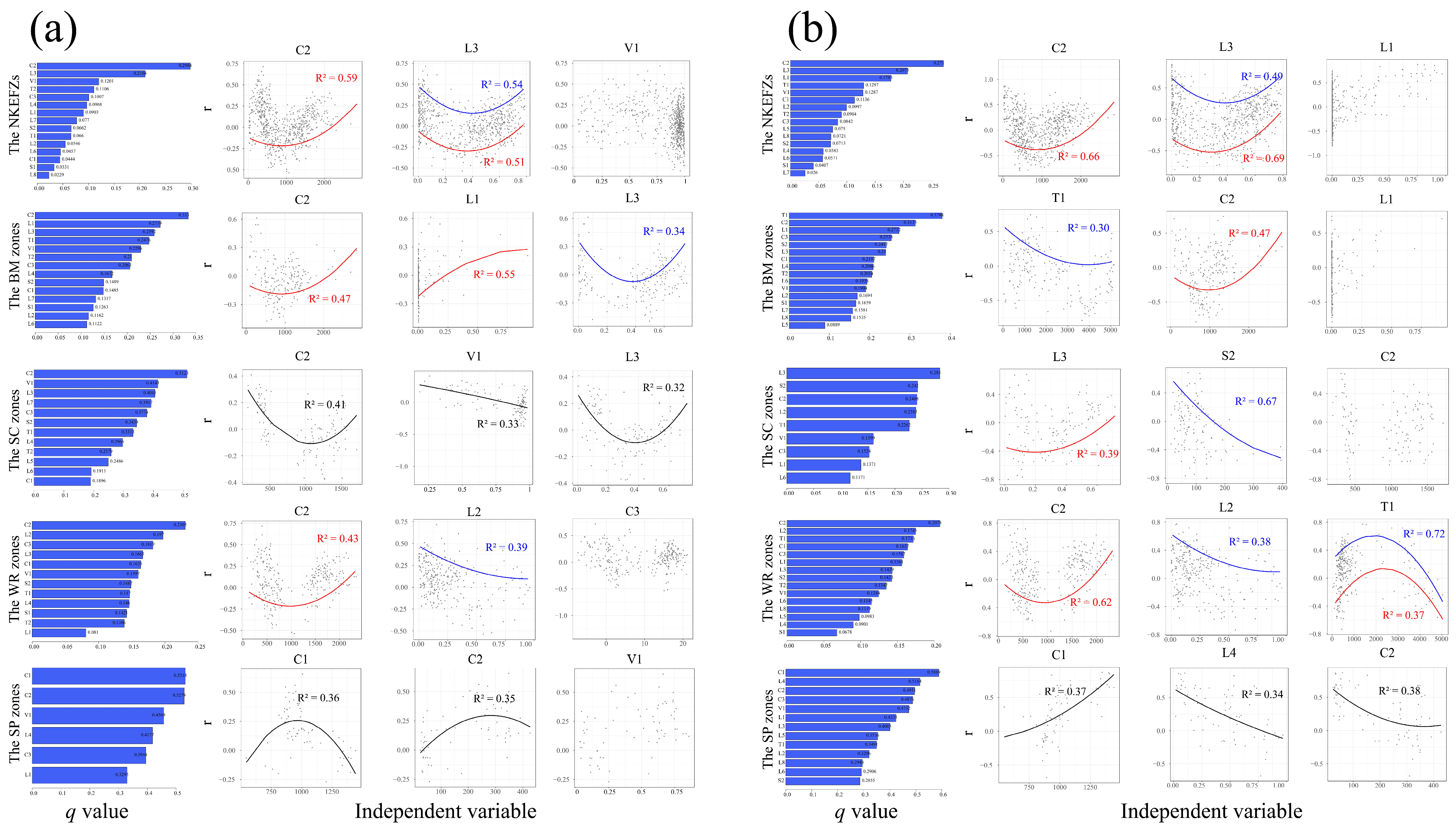
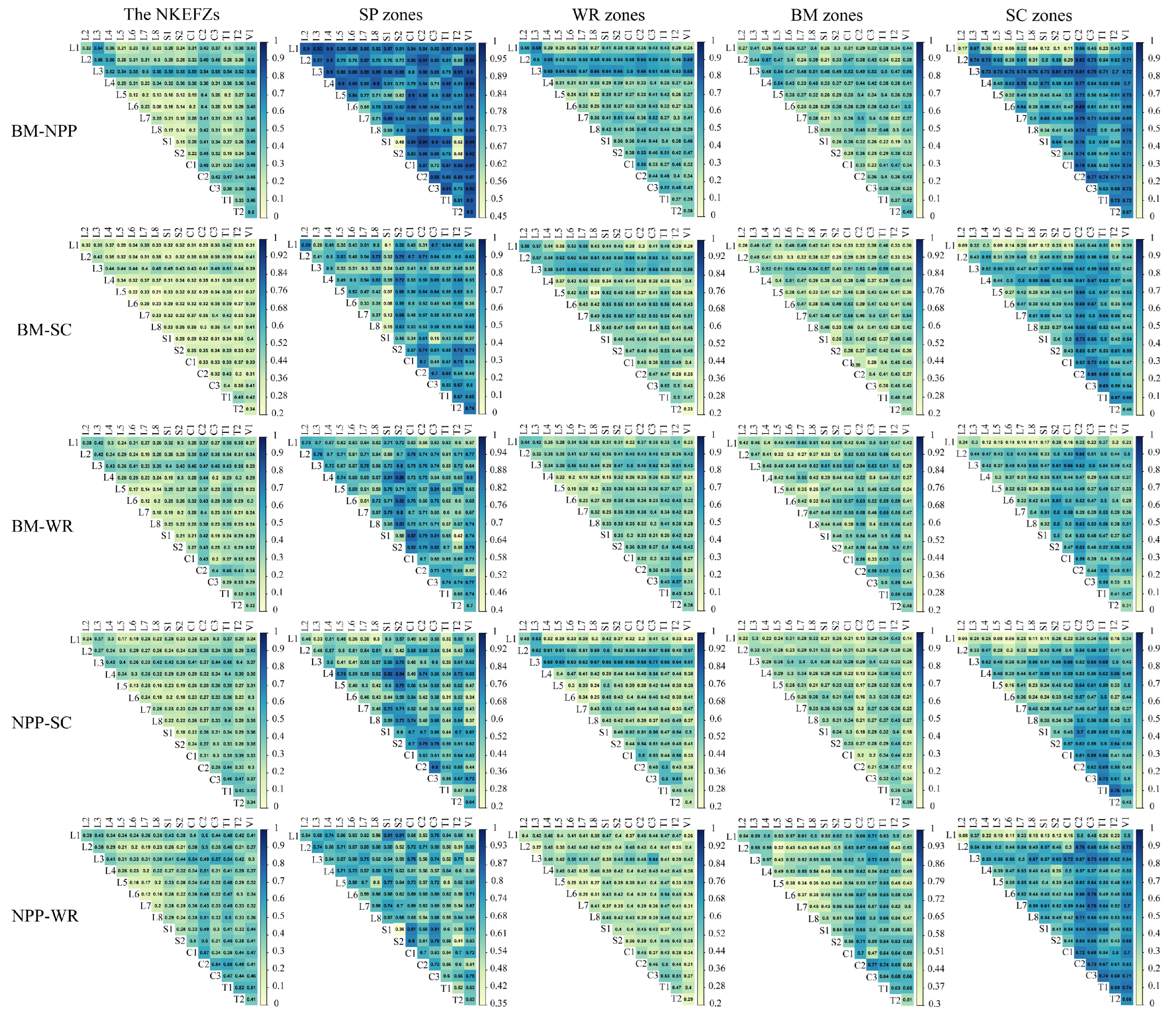
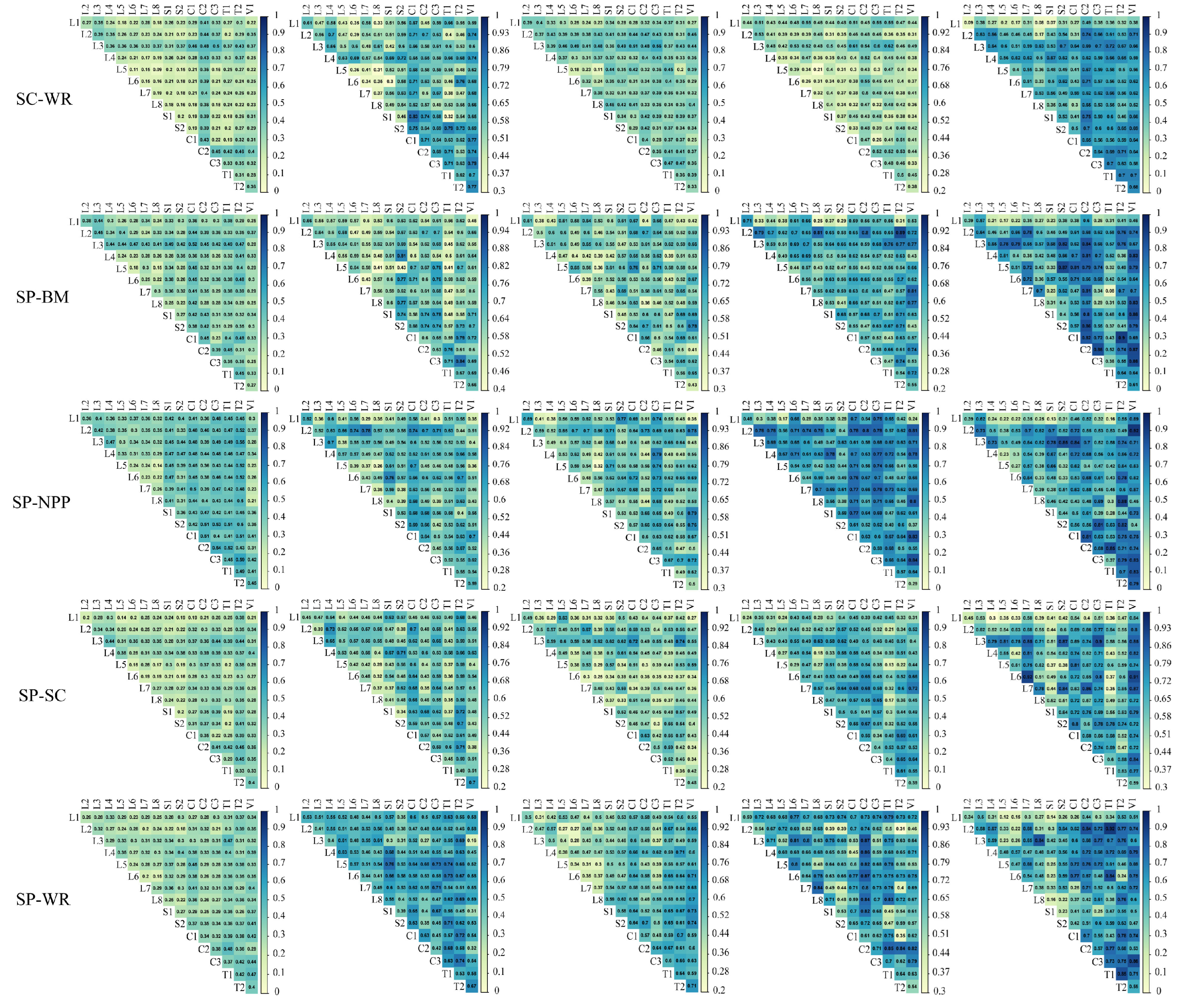
| Number | Sen-Trends Classification | Judgement |
|---|---|---|
| 1 | Significant increase | β > 0, Z > 2.58 |
| 2 | Relatively significant increase | β > 0, 1.96 < Z ≤ 2.58 |
| 3 | Non-significant change | |Z| ≤ 1.96 |
| 4 | Relatively significant decrease | β < 0, −2.58 ≤ Z < −1.96 |
| 5 | Significant decrease | β < 0, Z < −2.58 |
| Code | Description | Unit |
|---|---|---|
| L1 | Proportion of bare lands | / |
| L2 | Proportion of croplands | / |
| L3 | Proportion of forest lands | / |
| L4 | Proportion of grasslands | / |
| L5 | Patch density | / |
| L6 | Contagion | / |
| L7 | Shannon’s diversity index | / |
| L8 | Aggregation index | / |
| T1 | DEM | m |
| T2 | Slope | % |
| V1 | NDVI | / |
| S1 | GDP | USD |
| S2 | Population density | % |
| C1 | Annual potential evapotranspiration | mm |
| C2 | Annual precipitation | mm |
| C3 | Annual average temperature | °C |
| Type | NPP Area Ratio (%) | Biodiversity Maintenance Area Ratio (%) | Soil Conservation Area Ratio (%) | Water Retention Area Ratio (%) | Sandstorm Prevention Area Ratio (%) |
|---|---|---|---|---|---|
| Significant increase | 32.8 | 3.6 | 7.4 | 2.7 | 25.0 |
| Relatively significant increase | 11.8 | 0.1 | 5.2 | 9.9 | 11.1 |
| Non-significant change | 54.7 | 94.4 | 84.2 | 84.0 | 60.6 |
| Relatively significant decrease | 0.4 | 0.1 | 2.4 | 2.5 | 1.8 |
| Significant decrease | 0.3 | 1.8 | 0.8 | 0.9 | 1.5 |
Disclaimer/Publisher’s Note: The statements, opinions and data contained in all publications are solely those of the individual author(s) and contributor(s) and not of MDPI and/or the editor(s). MDPI and/or the editor(s) disclaim responsibility for any injury to people or property resulting from any ideas, methods, instructions or products referred to in the content. |
© 2025 by the authors. Licensee MDPI, Basel, Switzerland. This article is an open access article distributed under the terms and conditions of the Creative Commons Attribution (CC BY) license (https://creativecommons.org/licenses/by/4.0/).
Share and Cite
Zhang, T.; Shao, Q.; Huang, H. Unveiling the Spatial Variation in Ecosystem Services Interactions and Their Drivers Within the National Key Ecological Function Zones, China. Remote Sens. 2025, 17, 1559. https://doi.org/10.3390/rs17091559
Zhang T, Shao Q, Huang H. Unveiling the Spatial Variation in Ecosystem Services Interactions and Their Drivers Within the National Key Ecological Function Zones, China. Remote Sensing. 2025; 17(9):1559. https://doi.org/10.3390/rs17091559
Chicago/Turabian StyleZhang, Tingjing, Quanqin Shao, and Haibo Huang. 2025. "Unveiling the Spatial Variation in Ecosystem Services Interactions and Their Drivers Within the National Key Ecological Function Zones, China" Remote Sensing 17, no. 9: 1559. https://doi.org/10.3390/rs17091559
APA StyleZhang, T., Shao, Q., & Huang, H. (2025). Unveiling the Spatial Variation in Ecosystem Services Interactions and Their Drivers Within the National Key Ecological Function Zones, China. Remote Sensing, 17(9), 1559. https://doi.org/10.3390/rs17091559







